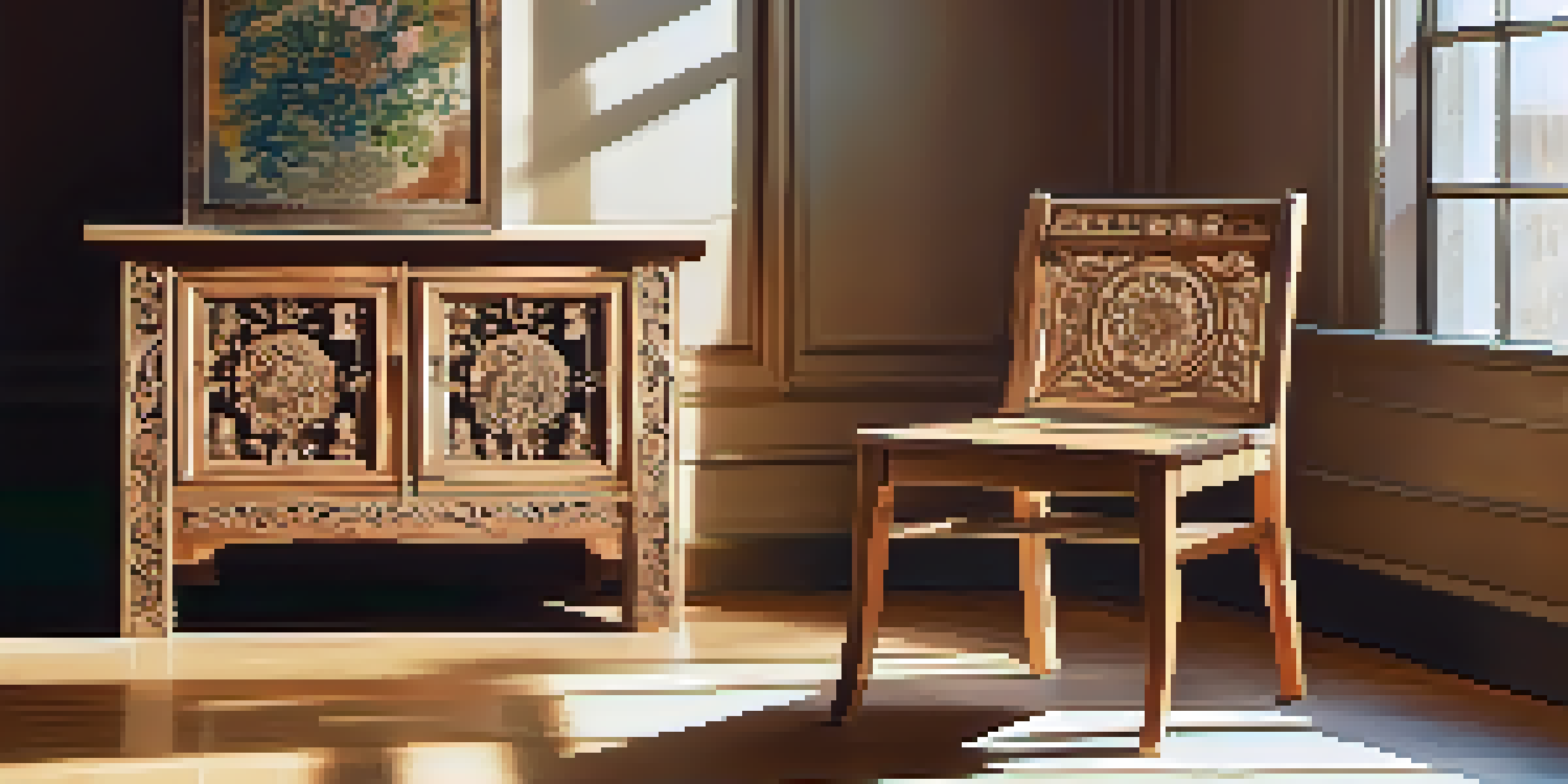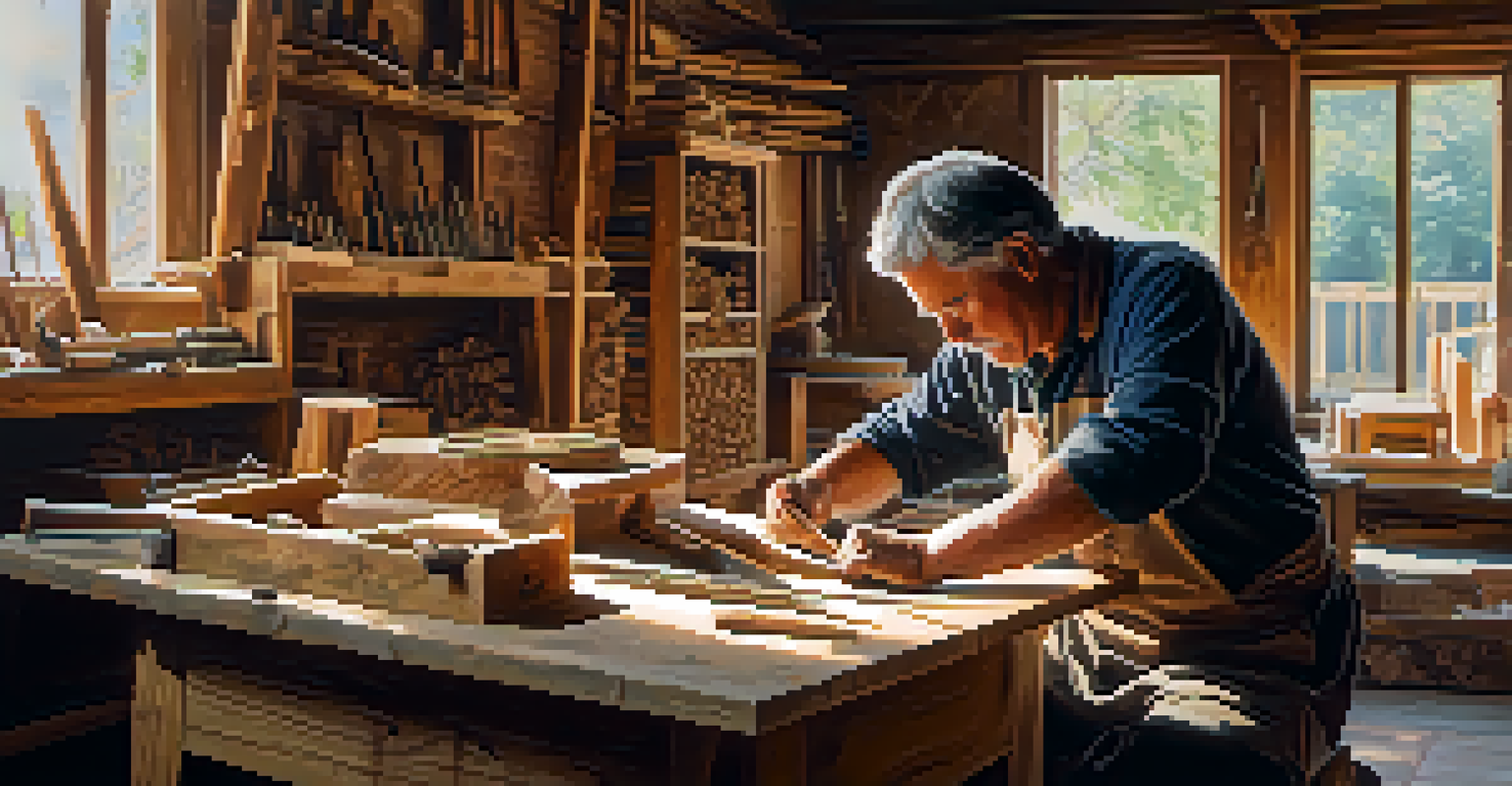The Role of Carving in Sustainable Furniture Design

Understanding Sustainable Furniture Design Principles
Sustainable furniture design focuses on creating pieces that are environmentally friendly and socially responsible. This means using materials and methods that reduce waste and pollution while promoting longevity. Carving plays a significant role in this process by allowing artisans to craft unique designs that enhance the aesthetic value and usability of furniture.
Sustainability is not a trend; it's a responsibility.
By incorporating sustainable practices, such as sourcing reclaimed wood or using eco-friendly finishes, designers can create stunning pieces that tell a story. Carving can elevate these designs, making them not only functional but also works of art. This connection between sustainability and craftsmanship is crucial for attracting environmentally conscious consumers.
Ultimately, sustainable furniture design is about balancing beauty and responsibility. Carving techniques help achieve this balance, ensuring that each piece is not only visually appealing but also contributes positively to the planet.
The Art of Carving: A Blend of Tradition and Innovation
Carving is an ancient art form that has been passed down through generations. This craft not only adds beauty to furniture but also reflects cultural heritage and craftsmanship. In sustainable furniture design, artisans blend traditional carving techniques with modern innovations to create unique pieces that stand out in a crowded market.

For instance, some designers use CNC machines to assist in intricate carving processes, ensuring precision while maintaining the hand-crafted feel. This fusion allows for the creation of complex designs that might be difficult to achieve solely by hand. The result is furniture that honors tradition while embracing modern technology.
Sustainability Through Craftsmanship
Sustainable furniture design combines environmentally friendly materials and techniques with artisanal craftsmanship to create beautiful, lasting pieces.
As a result, carved furniture pieces become conversation starters, showcasing the story behind their creation. This blend of tradition and innovation not only elevates the design but also enhances its sustainability by promoting the use of skilled labor and reducing reliance on mass production.
Carving Techniques That Support Sustainability
Various carving techniques contribute to sustainable furniture design, each bringing its own unique flair. Techniques like relief carving, where designs are sculpted into the surface, can create stunning visuals without using excessive materials. This method ensures that the integrity of the wood is preserved while still delivering a beautiful aesthetic.
The best furniture is not just about what it looks like, but also about the story it tells.
Another approach is the use of negative space in carving, which minimizes waste by removing only what's necessary to achieve the desired effect. This not only makes the piece lighter and more visually interesting but also aligns with sustainable practices by conserving resources. Each cut and groove is carefully considered, reflecting a commitment to reducing the environmental impact.
Moreover, these techniques encourage a deeper connection between the artisan and the material. As craftsmen work with the wood, they become more attuned to its properties, leading to more thoughtful designs that maximize sustainability. This mindful approach is essential for creating furniture that lasts.
The Environmental Impact of Carved Furniture
The environmental impact of furniture production is often overlooked, but carved furniture can significantly mitigate this issue. By utilizing sustainably sourced materials, such as reclaimed wood, artisans can reduce the demand for new timber, helping to preserve forests. Carving allows designers to maximize the use of these materials, creating beautiful pieces with minimal waste.
Additionally, carved furniture tends to be more durable than mass-produced alternatives. The intricate craftsmanship involved in carving often results in higher quality pieces that can withstand the test of time. This longevity is a crucial factor in sustainability, as it reduces the need for frequent replacements and lessens the overall carbon footprint.
Carving Blends Tradition with Tech
The art of carving in furniture design merges traditional techniques with modern technology, enhancing creativity and precision while maintaining sustainability.
In essence, each carved piece becomes a testament to responsible consumption. Consumers are not just purchasing furniture; they are investing in sustainable practices that benefit the environment, making their choices more meaningful.
Consumer Demand for Sustainable Carved Furniture
As awareness of environmental issues grows, so does consumer demand for sustainable products, including carved furniture. People are increasingly looking for pieces that reflect their values and contribute positively to the planet. This shift in consumer behavior has prompted many designers to prioritize sustainability in their creations.
Carved furniture appeals to this market by offering unique, handcrafted designs that stand out from mass-produced items. Consumers appreciate the artistry and craftsmanship that goes into each piece, making them feel more connected to their furniture. This emotional connection often leads to a greater appreciation for sustainability and ethical sourcing.
Ultimately, this demand drives innovation within the industry. Designers are motivated to explore new techniques and materials that align with sustainable practices, ensuring that the future of furniture design is as beautiful as it is responsible.
The Future of Carving in Sustainable Design
The future of carving in sustainable furniture design looks promising as artisans continue to push the boundaries of creativity. With advancements in technology and a growing emphasis on sustainability, we can expect to see even more innovative carving techniques emerge. These developments will allow designers to create stunning pieces while minimizing environmental impact.
Moreover, as consumers become more educated about the benefits of sustainable furniture, the demand for carved pieces will likely increase. This trend encourages artisans to hone their skills and explore new materials, ensuring that carving remains a vital part of furniture design. The blend of artistry and sustainability will continue to resonate with those seeking unique, eco-friendly options.
Growing Demand for Eco-Friendly Furniture
As consumers increasingly seek sustainable products, carved furniture offers unique designs that resonate with their values and contribute to a healthier planet.
In summary, the role of carving in sustainable furniture design is evolving, and its future is bright. As we embrace creativity and responsibility, carved furniture will undoubtedly find its place in homes around the world, enriching lives while protecting our planet.
Conclusion: Carving as a Sustainable Choice
In conclusion, carving plays a pivotal role in sustainable furniture design, marrying artistry with environmental responsibility. By utilizing traditional techniques and innovative practices, artisans can create stunning pieces that not only enhance our living spaces but also promote sustainable values. This balance is essential in a world increasingly focused on minimizing our ecological footprint.
Consumers are now more aware of the stories behind the products they purchase, and carved furniture often carries a rich narrative of craftsmanship and sustainability. This connection fosters a deeper appreciation for the items we choose to bring into our homes. Each carved piece serves as a reminder of the care and thoughtfulness that went into its creation.

As we look to the future, the importance of carving in sustainable furniture design will only continue to grow. By embracing this art form, we can ensure that our choices reflect our commitment to a healthier planet while enjoying the beauty and uniqueness that carved furniture brings.